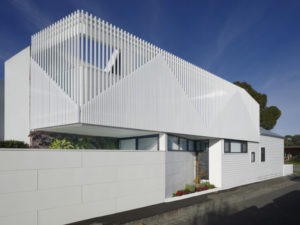The creation of the Tua Valley Interpretive Centre is part of a wider reaching programme included in the compensation measures
associated with the construction of the Foz Tua dam. The purpose is to provide visitors with information about the history and
transformation of the valley. This Centre is housed in two old railway hangars that were no longer in use, sited on either side of Tua
railway station. In the heart of UNESCO’s Douro World Heritage Site and at km 0 of the Tua Line, the opportunity to develop this small
project was a major responsibility for us, in view of expectations and of the place that we found. In keeping with the project aims, another
aspect we considered vital was using this work as an anchor to qualify and positively contribute to the small built nucleus, clarifying
volumetries, simplifying architectural languages and expanding into the public space gestures that can be followed up in the future.
Confronted with an intervention in two buildings we decided that each one should be given a unique but complementary identity.
Wooden building
This hundred-year-old hangar was restored plank by plank, with a few new inserts here and there. It is given over to temporary
exhibitions, accommodates the major visitor reception centre and has a small shop attached. Given the archetypical language of the
construction, the west front was altered to serve as the entrance and enhance the relation with the landscape. This intervention also
involved creating exterior access platforms, with a more obvious treatment of the public space and the connection to the street. As far as
the construction is concerned, thermal insulation and an air chamber were introduced by applying an inner lining in new dark-stained
timber and the placement of a series of delicate steel and glass frames in the space between the top of the lining and the tiles on the
north and south elevations, creating the necessary conditions of comfort. Finally, a detached wooden volume/container was built to
house the toilets and storage areas, so that the space can be read as a whole, whilst the original structure is enhanced in keeping with the
various perfectly identifiable periods of the intervention.
Zinc building
The intervention in this building of the Tua Valley Interpretive Centre went quite deep in response to the challenging programme. The
idea was to exploit a more direct relation with Tua railway station, which is reflected from the outset in the connection forged between
the new west façade and the void opposite – a graceful iron footbridge over a small existing garden set about with examples of railway
archaeology. Similarly, it was decided to give the existing building (reconstructed after a fire in 2009) a more contemporary treatment.
The decision to cover the building with zinc reconciled what to us were two almost antagonistic choices: applying a material to blend with
the industrial nature of this site (the imagery of railways, coaches, water towers, etc.) whilst simultaneously showcasing an noteworthy
dimension in keeping with the Douro’s status as a UNESCO World Heritage Site. Therefore, we strove to achieve the right proportion and
scale in defining the corrugated zinc sheeting that was installed on the roof and along the façades, reinterpreting the metrics and textures
present in the wooden hangar located on the other side of the railway line, so unifying the different construction eras of this building. In
order to cover the whole programme the area was extended as far as was possible taking into account the restrictions inherent to an
active train service. The side platforms were eliminated and a thick wall with an air chamber was built behind the zinc cladding, creating
natural ventilation and minimizing the use of air-conditioning equipment. This subtle transversal extension freed up more space for the
areas of the permanent exhibition located inside this building. The exhibition provides information in an accessible and didactic way using
graphs, multimedia and interactive programmes organized in three themed units. The shape of the first unit is reminiscent of a tunnel on
the old Tua railway line, along which the visitor takes a sensory trip through the valley, revealing biodiversity, geomorphology and the
heritage through films and images as well as through aromas. The second unit tells the story of the construction of the Foz Tua to
Mirandela railway line through documents and images. The third unit presents the Foz Tua dam construction project. The upper floor
houses educational service areas and other workspaces on the mezzanine. In short, and with substantial savings, the zinc skin shows that
it is possible to change a building completely without destroying its character and to alter its use without betraying the identity of the
place.












